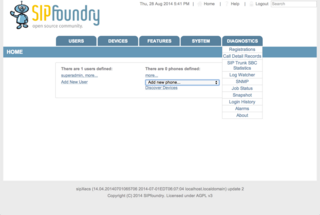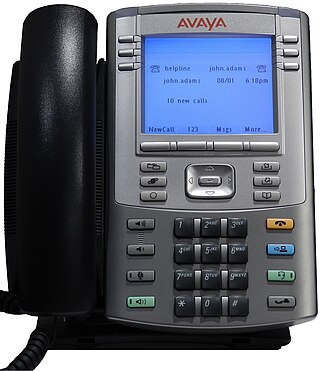Related Research Articles
The Telephony Application Programming Interface (TAPI) is a Microsoft Windows API, which provides computer telephony integration and enables PCs running Microsoft Windows to use telephone services. Different versions of TAPI are available on different versions of Windows. TAPI allows applications to control telephony functions between a computer and telephone network for data, fax, and voice calls. It includes basic functions, such as dialing, answering, and hanging up a call. It also supports supplementary functions, such as hold, transfer, conference, and call park found in PBX, ISDN, and other telephone systems.
Voice over Internet Protocol (VoIP), also called IP telephony, is a method and group of technologies for voice calls for the delivery of voice communication sessions over Internet Protocol (IP) networks, such as the Internet.
A voicemail system is a computer-based system that allows callers to leave a recorded message when the recipient has been unable or unwilling to answer the phone. Calls may be diverted to voicemail manually or automatically. The caller is prompted to leave a message and the recipient can retrieve the message at a later time.
HCL Sametime Premium is a client–server application and middleware platform that provides real-time, unified communications and collaboration for enterprises. Those capabilities include presence information, enterprise instant messaging, web conferencing, community collaboration, and telephony capabilities and integration. Currently it is developed and sold by HCL Software, a division of Indian company HCL Technologies, until 2019 by the Lotus Software division of IBM.

Asterisk is a software implementation of a private branch exchange (PBX). In conjunction with suitable telephony hardware interfaces and network applications, Asterisk is used to establish and control telephone calls between telecommunication endpoints such as customary telephone sets, destinations on the public switched telephone network (PSTN) and devices or services on voice over Internet Protocol (VoIP) networks. Its name comes from the asterisk (*) symbol for a signal used in dual-tone multi-frequency (DTMF) dialing.

A business telephone system is a telephone system typically used in business environments, encompassing the range of technology from the key telephone system (KTS) to the private branch exchange (PBX).

Skype for Business Server is real-time communications server software that provides the infrastructure for enterprise instant messaging, presence, VoIP, ad hoc and structured conferences and PSTN connectivity through a third-party gateway or SIP trunk. These features are available within an organization, between organizations and with external users on the public internet or standard phones.

SipXecs is a free software enterprise communications system. It was initially developed by Pingtel Corporation in 2003 as a voice over IP telephony server located in Boston, MA. The server was later extended with additional collaboration capabilities as part of the SIPfoundry project. Since its extension, sipXecs now acts as a software implementation of the Session Initiation Protocol (SIP), making it a full IP-based communications system.
Mobile VoIP or simply mVoIP is an extension of mobility to a voice over IP network. Two types of communication are generally supported: cordless telephones using DECT or PCS protocols for short range or campus communications where all base stations are linked into the same LAN, and wider area communications using 3G or 4G protocols.

Avaya IP Phone 1140E in telecommunications is a desktop Internet Protocol client from 1100-series manufactured by Avaya for unified communications. The phone can operate on the Session Initiation Protocol (SIP) or UNIStim protocols. The SIP firmware supports presence selection and notification along with secure instant messaging. This device has an integrated 10/100/1000BASE-T auto-sensing Ethernet switch with two ports and an integrated USB port, and is Bluetooth capable. The SIP version of this phone has full IPv6 functionality and only requires 2.9 watts of power.
The Innovative Communications Alliance (ICA) was a telecommunications alliance between Microsoft and Nortel, created in July 2006, to co-develop, integrate, market, sell, and support unified communications products. The goal of the alliance is to make integrated hardware and software solutions that join together voice, video, and data communications without requiring gateways or middleware. Microsoft and Nortel share developing technologies and patents for unified communications products.
Objectworld Communications Corp., formerly ObjectWorld Inc, was a privately held company that provides unified communications software to small- and medium-sized businesses. Objectworld was acquired by Huntsville, Alabama-based ADTRAN Inc.
Cloud communications are Internet-based voice and data communications where telecommunications applications, switching and storage are hosted by a third-party outside of the organization using them, and they are accessed over the public Internet. Cloud services is a broad term, referring primarily to data-center-hosted services that are run and accessed over an Internet infrastructure. Until recently, these services have been data-centric, but with the evolution of VoIP, voice has become part of the cloud phenomenon. Cloud telephony refers specifically to voice services and more specifically the replacement of conventional business telephone equipment, such as a private branch exchange (PBX), with third-party VoIP service.
The Unified Communications Interoperability Forum (UCIF) is a non-profit alliance between communications technology vendors. It was announced on May 19, 2010, with the vision to maximize the interoperability of UC based on existing standards. Founding members of UCIF were HP, Microsoft, Polycom, Logitech / LifeSize Communications, and Juniper Networks. On July 28, 2014, UCIF merged with International Multimedia Telecommunications Consortium (UMTC) into one consortium.
Callware Technologies, Inc. (Callware) is a software company in the telecommunication industry, headquartered in Salt Lake City, Utah. It specializes in developing unified communication and unified messaging solutions for the US Department of Defense, government, educational institutions, and mid to enterprise business.
SunComm Technology Co. Ltd. is a Taiwan multinational computer technology and GSM Voice over IP gateway manufacturer. The main products in 2010 focused on GSM VoIP gateways & IP surveillance camera devices. Core members have been engaging in the communication & networks industry since 1977.
The 1100-series IP phones are 6 different desktop IP clients manufactured by Avaya for Unified communications which can operate on the SIP or UNIStim protocols. The SIP Firmware supports presence selection and notification along with secure instant messaging.
Unified communications (UC) management is essentially the management of unified communications; it refers to the systems used by enterprise organizations to automate their enterprise communications services and the voice network infrastructure that those services run over.
Bicom Systems is a producer and vendor of Asterisk (PBX)-based unified communications devices for VoIP businesses. Bicom Systems uses open standards telephony. Products include all of the software and hardware components involved in building a VoIP business or ITSP.
References
- ↑ Pleasant, Blair (2008-07-28). "What UC is and isn't". SearchUnifiedCommunications.com. Archived from the original on 2010-09-23. Retrieved 2013-07-26.
UC is not a single product but rather a solution made up of a variety of communication tools and components. [...] UC is a comprehensive solution that ties several components together with user experience.
- ↑ "Cloud network architecture and ICT". techtarget.com. Archived from the original on 20 September 2017. Retrieved 25 April 2018.
- ↑ "BCStrategies". www.ucstrategies.com. Archived from the original on 1 February 2018. Retrieved 25 April 2018.
- ↑ "BCStrategies". www.ucstrategies.com. Archived from the original on 16 June 2017. Retrieved 25 April 2018.
- ↑ "The Front Pager Poet System Has Write Stuff For Those In Motion". sun-sentinel.com. Archived from the original on 10 December 2015. Retrieved 25 April 2018.
- ↑ "Succession MX Basics". Avaya. July 2003. Archived from the original on 2016-07-29.
- ↑ Judge, Peter (March 19, 2004). "Nortel launches MCS 5100 worldwide". ComputerWeekly.com. Archived from the original on 2017-08-17.
- ↑ History - Courtesy of Mark H. Turpin, Senior Consultant - Unified Communications, Calence, LLC
- ↑ "IBM Aims Sametime at Microsoft Users". PCWorld. Archived from the original on 5 June 2011. Retrieved 25 April 2018.
- ↑ Follett, Jennifer (16 October 2007). "Gates Launches Microsoft VoIP Portfolio, Predicts Demise of PBX". crn.com. Archived from the original on 16 September 2008. Retrieved 25 April 2018.
- ↑ "Linux Communications Suite Enters Beta". PCWorld. Archived from the original on 27 August 2011. Retrieved 25 April 2018.
- ↑ "UCIF". www.ucif.org. Archived from the original on 6 February 2018. Retrieved 25 April 2018.
- ↑ "Businesswire.com" (Press release). Retrieved 2010-05-19.
- ↑ Glenn, Christopher (2010-09-10). "Two Magic Quadrants for Unified Communications". Seamless Enterprise. Archived from the original on 2010-09-15. Retrieved 2009-09-14.
- ↑ "Hosted vs. On-site Unified Communications: Both Provide Advantages". eFax. 6 April 2012. Archived from the original on 2 February 2014. Retrieved 26 January 2014.
- ↑ Taylor, Steve (2006-05-06). "What's the difference between unified communications and unified messaging?". Network World. Archived from the original on 2009-09-13. Retrieved 2009-08-08.
- ↑ Pleasant, Blair (2008-07-28). "What UC is and isn't". SearchUnifiedCommunications.com. Archived from the original on 2010-09-23. Retrieved 2013-07-26.
- ↑ McGillicuddy, Shamus (2009-05-07). "Instant messaging strategies: Usage policy and training are key". SearchUnifiedCommunications.com. Retrieved 2009-05-07.
- ↑ "What is Cisco UC Provisioning?". Akkadian Labs. 2015-09-18. Archived from the original on 2017-11-07. Retrieved 2017-11-03.